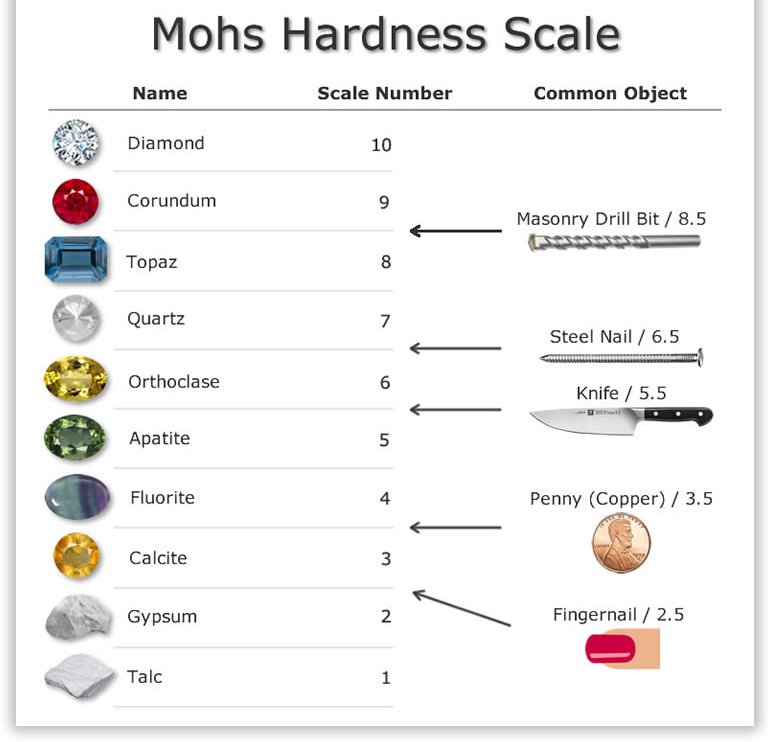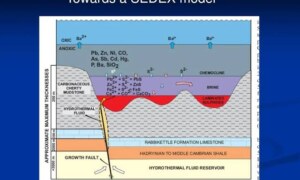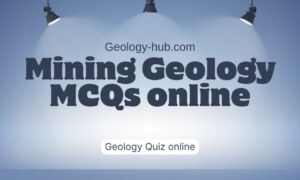Mohs hardness scale

The Mohs hardness scale is a qualitative scale used to measure the scratch resistance of various minerals or materials. It was developed by Friedrich Mohs, a German mineralogist, in 1812. The scale ranges from 1 to 10, with 1 being the softest and 10 being the hardest. Each mineral on the Mohs scale can scratch all minerals with a lower number and can be scratched by all minerals with a higher number.
Here is the list of minerals on the Mohs hardness scale:
- Talc: Easily scratched by fingernail.
- Gypsum: Can be scratched by a fingernail.
- Calcite: Can be scratched by a copper coin.
- Fluorite: Can be scratched by a steel knife.
- Apatite: Can be scratched by a glass plate.
- Orthoclase Feldspar: Can be scratched by a steel file.
- Quartz: Can scratch glass and is commonly used in glassmaking.
- Topaz: Harder than glass and can scratch it.
- Corundum: Includes gemstones like rubies and sapphires.
- Diamond: The hardest mineral on the Mohs scale, used in various industrial applications.
The Mohs scale is useful for geologists, mineralogists, and anyone dealing with minerals or materials in various industries. It provides a simple and quick way to determine the relative hardness of different substances. Keep in mind that the Mohs scale is a relative scale, meaning the intervals between the numbers are not uniform in terms of hardness. For example, corundum (9) is much harder than topaz (8), and diamond (10) is significantly harder than corundum.
Mohs Hardness Scale
| Mineral Image | Hardness Level | Mineral Name | Common Object Example |
|---|---|---|---|
 | 10 | Diamond | Diamond |
 | 9 | Corundum | Tungsten Carbide |
 | 8 | Topaz | Scratch Plate |
 | 7 | Quartz | Hardened Steel |
 | 6 | Orthoclase | Steel File |
 | 5 | Apatite | Glass Plate |
 | 4 | Fluorite | Knife Blade |
 | 3 | Calcite | Copper Coin |
 | 2 | Gypsum | Fingernail |
 | 1 | Talc | Fingernail |
| Hardness | Substance |
| 0.2–0.4 | Caesium, potassium, rubidium, butter |
| 0.5–0.6 | Lithium, sodium, graphite, candle wax |
| 1 | Talc |
| 1.5 | Tin, lead, ice, todorokite, wakabayashilite, idrialite, dimorphite |
| 2 | Gypsum, calcium, hardwood, dry ice (solid form of carbon dioxide) |
| 2–2.5 | Bismuth, plastic |
| 2.5 | Gold, silver, magnesium, zinc, pearl, amber, ivory, finger nail, galena, linarite, ulexite, kinoite, cylindrite |
| 2.5–3 | Copper, aluminium, chalcocite, jet |
| 3 | Calcite, thorium, dentin, chalk, brass, bronze |
| 3.5 | Platinum, adamite, strontianite, roselite, ludlamite |
| 3.5-4 | Sphalerite |
| 4 | Fluorite, iron, nickel, heazlewoodite |
| 4–4.5 | Ordinary steel |
| 4.5 | Conichalcite, duftite, colemanite, lindgrenite |
| 5 | Apatite, tooth enamel, zirconium, obsidian (volcanic glass) |
| 5-5.5 | Goethite |
| 5.5 | Cobalt, beryllium, glass, perovskite, chromite, bavenite, agrellite |
| 5.5-6 | Opal, turquoise, anatase |
| 6 | Orthoclase feldspar, titanium, uranium, rhodium |
| 6-6.5 | Rutile, pyrite |
| 6.5 | Silicon, iridium, baddeleyite, chloritoid, berlinite, cuprospinel |
| 6.5-7 | Peridot, jadeite |
| 7 | Quartz (including amethyst and citrine), porcelain, bowieite |
| 7-7.5 | Garnet |
| 7.5 | Tungsten, zircon, euclase, hambergite, grandidierite |
| 7.5-8 | Beryl (including emerald and aquamarine) |
| 8 | Topaz, cubic zirconia, spinel, hardened steel |
| 8.5 | Chromium, silicon nitride, tantalum carbide, chrysoberyl, tongbaite |
| 9 | Corundum (including ruby and sapphire), tungsten carbide, titanium nitride |
| 9–9.5 | Moissanite, silicon carbide (carborundum), tantalum carbide, zirconium carbide, beryllium carbide, titanium carbide, aluminium boride, boron carbide. |
| 9.5 – near 10 | Boron, boron nitride, rhenium diboride, titanium diboride, boron carbide |
| 10 | Diamond |
It’s important to note that the Mohs scale is not linear, meaning that a mineral with a hardness of 8 is not twice as hard as one with a hardness of 4. Instead, it is an ordinal scale, which means that it simply ranks the minerals in order of hardness without specifying the exact amount of hardness between each mineral.
The Mohs scale is often used in geology, mineralogy, and materials science to determine the relative hardness of different minerals. This can be useful for identifying unknown minerals, as well as for understanding the properties of different materials used in construction, industry, and jewelry making.
To use the Mohs scale, a mineral is scratched against the surface of another mineral with a known hardness. If the mineral being tested is harder than the one it is scratching, it will leave a visible scratch on the surface. If it is softer, it will not leave a scratch. This process is repeated with minerals of increasing hardness until a mineral is found that the specimen being tested cannot scratch. The hardness of the specimen is then assigned the number of the mineral it was unable to scratch.
It’s worth mentioning that the Mohs scale only measures the hardness of the surface of the mineral, not the entire specimen. Also, it only measures the ability to scratch, not other properties like toughness, brittleness, or cleavage. Additionally, the Mohs scale is not appropriate for measuring the hardness of metallic and other non-mineral materials.
Despite these limitations, the Mohs scale is a widely accepted and useful tool for measuring the relative hardness of minerals. It has been used for over 200 years and continues to be an important tool in geology, mineralogy, and materials science.
In summary, the Mohs hardness scale is a method for measuring the relative hardness of minerals, developed by Friedrich Mohs in 1812, ranging from 1 to 10, with 1 being the softest and 10 being the hardest. It is based on the ability of one mineral to scratch another, and it is an ordinal scale, which means that it simply ranks the minerals in order of hardness without specifying the exact amount of hardness between each mineral. It’s widely used in geology, mineralogy, and materials science to determine the relative hardness of different minerals.


Leave a comment